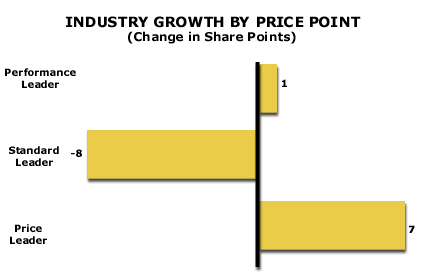Analysis 40: Industry Growth by Product Price Point
EXHIBITS:

HOW TO INTERPRET THE ANALYSIS: This exhibit shows the change in unit market share for three Price Points in the marketplace. Both the Performance Leader and Price Leader Price Points are growing at the expense of the Standard Leader products. The Price Leader product category is particularly fast growing. Any company in the industry without a Price Leader product is likely to be losing share.
PURPOSE: This analysis builds a case for the company's development of its product price point mix. In general, the company will want to cover any price point that is growing in the marketplace, as long as its target Core customers will buy at that price point. Failure to cover growing price points is likely to cost the company both volume and profitability in the short to medium term. APPROACH: The company measures the industry total unit volume by price point at the beginning and end of the period. It then calculates the share that each price point had at the beginning of the period and at the end of the period. The differences in these shares from the beginning of the period to the end of the period represent the change in share points for each product price point. The sum of these share point differences is zero.
Examples of: |
|
Recommended Reading |
| For a greater overall perspective on this subject, we recommend the following related items:
Analyses: Symptoms and Implications: Symptoms developing in the market that would suggest the need for this analysis.
Perspectives: Conclusions we have reached as a result of our long-term study and observations.
|
